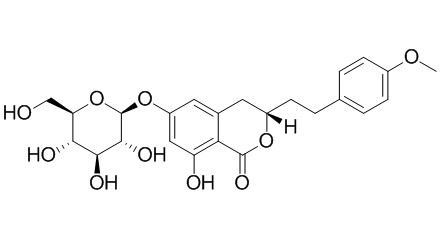Agrimonolide 6-O-glucoside
Agrimonolide-6-O-glucopyranoside has antimicrobial activity.
Inquire / Order:
manager@chemfaces.com
Technical Inquiries:
service@chemfaces.com
Tel:
+86-27-84237783
Fax:
+86-27-84254680
Address:
1 Building, No. 83, CheCheng Rd., Wuhan Economic and Technological Development Zone, Wuhan, Hubei 430056, PRC
Providing storage is as stated on the product vial and the vial is kept tightly sealed, the product can be stored for up to
24 months(2-8C).
Wherever possible, you should prepare and use solutions on the same day. However, if you need to make up stock solutions in advance, we recommend that you store the solution as aliquots in tightly sealed vials at -20C. Generally, these will be useable for up to two weeks. Before use, and prior to opening the vial we recommend that you allow your product to equilibrate to room temperature for at least 1 hour.
Need more advice on solubility, usage and handling? Please email to: service@chemfaces.com
The packaging of the product may have turned upside down during transportation, resulting in the natural compounds adhering to the neck or cap of the vial. take the vial out of its packaging and gently shake to let the compounds fall to the bottom of the vial. for liquid products, centrifuge at 200-500 RPM to gather the liquid at the bottom of the vial. try to avoid loss or contamination during handling.
Foods.2021, 10(12):2929.
Food Science and Biotechnology2022, 10.1007.
J. Traditional Thai Medical Res. 2022,8(1):1-14.
Progress In Microbes & Molecular Biology2025, 8,1:a0000470.
Inflammation.2020, 43(5):1716-1728.
Int J Mol Sci.2019, 20(23):E6071
BMB Rep.2020, 53(4):218-222.
Naunyn Schmiedebergs Arch Pharmacol.2017, 390(10):1073-1083
Cell Physiol Biochem.2017, 44(4):1381-1395
J Liq Chromatogr R T2025, 2505536.
Related and Featured Products
University of East London, 2013.
Investigation of antimicrobials from native British plants used in 10th century Anglo-Saxon wound healing formulations[Reference:
WebLink]
METHODS AND RESULTS:
Seven antimicrobial compounds were putatively identified for P. reptans (agrimonolide-6-O-glucopyranoside, chlorogenic acid, ellagic acid, epicatechin, procyanidin B, procyanidin C, and tormentic acid).
CONCLUSIONS:
This study has shown some native species in the Anglo-Saxon formulations may have been effective for treating bacterial infection in wounds and that the medical texts are a valuable source for rediscovering plants and medicinal uses lost to Western herbal practice.
Phytochemistry. 2010 Nov;71(16):1925-9.
Phenolic glycosides from Agrimonia pilosa.[Pubmed:
20810135]
METHODS AND RESULTS:
Phytochemical investigation of the methanolic extract from the aerial parts of Agrimonia pilosa led to the isolation of three compounds, (-)-aromadendrin 3-O-β-D-glucopyranoside, desmethylagrimonolide 6-O-β-D-glucopyranoside, and 5,7-dihydroxy-2-propylchromone 7-O-β-D-glucopyranoside, together with nine known compounds, Agrimonolide 6-O-glucoside, takanechromone C, astragalin, afzelin, tiliroside, luteolin, quercetin, isoquercetrin, and quercitrin.
CONCLUSIONS:
Their structures were determined by various spectroscopic analysis and chemical transformations.



